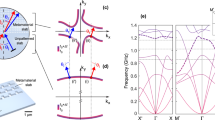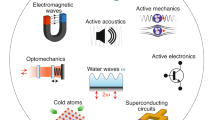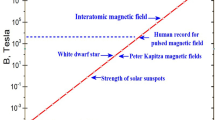Abstract
Einstein’s general theory of relativity establishes equality between matter–energy density and the curvature of spacetime. As a result, light and matter follow natural paths in the inherent spacetime and may experience bending and trapping in a specific region of space. So far, the interaction of light and matter with curved spacetime has been predominantly studied theoretically and through astronomical observations. Here, we propose to link the newly emerged field of artificial optical materials to that of celestial mechanics, thus opening the way to investigate light phenomena reminiscent of orbital motion, strange attractors and chaos, in a controlled laboratory environment. The optical–mechanical analogy enables direct studies of critical light/matter behaviour around massive celestial bodies and, on the other hand, points towards the design of novel optical cavities and photon traps for application in microscopic devices and lasers systems.
This is a preview of subscription content, access via your institution
Access options
Subscribe to this journal
Receive 12 print issues and online access
$209.00 per year
only $17.42 per issue
Buy this article
- Purchase on Springer Link
- Instant access to full article PDF
Prices may be subject to local taxes which are calculated during checkout



Similar content being viewed by others
References
Pendry, J. B. Negative refraction makes a perfect lens. Phys. Rev. Lett. 85, 3966–3969 (2000).
Shelby, R. A., Smith, D. R. & Schultz, S. Experimental verification of a negative index of refraction. Science 292, 77–79 (2001).
Leonhardt, U. Optical conformal mapping. Science 312, 1777–1780 (2006).
Pendry, J. B., Schurig, D. & Smith, D. R. Controlling electromagnetic fields. Science 312, 1780–1782 (2006).
Leonhardt, U. & Philbin, T. G. General relativity in electrical engineering. New J. Phys. 8, 247–265 (2006).
Fang, N., Lee, H., Sun, C. & Zhang, X. Sub-diffraction-limited optical imaging with a silver superlens. Science 308, 534–537 (2005).
Kox, A. J. et al. (eds) The Collected Papers of Albert Einstein Vol. 6 (Princeton Univ. Press, 1997).
Einstein, A. Lens-like action of a star by the deviation of light in the gravitational field. Science 84, 506–507 (1936).
de Maupertuis, P. L. M. Accord de différentes lois de la nature qui avaient jusqu’ici paru incompatibles. Mém. As. Sc. Paris 417–427 (1744).
Evans, J. The ray form of Newton’s law of motion. Am. J. Phys. 61, 347–350 (1993).
Plebanski, J. Electromagnetic waves in gravitational fields. Phys. Rev. 118, 1396–1408 (1960).
Kildishev, A. V. & Shalaev, V. M. Engineering space for light via transformation optics. Opt. Lett. 33, 43–45 (2008).
Valentine, J. et al. Three dimensional optical metamaterial exhibiting negative refractive index. Nature 455, 376–379 (2008).
Shapiro, S. L. & Teukolsky, S. A. White Dwarfs, and Neutron Stars: The Physics of Compact Objects (Wiley, 1983).
Leonhardt, U. & Piwnicki, P. Relativistic effects of light in moving media with extremely low group velocity. Phys. Rev. Lett. 84, 822–825 (2000).
Visser, M. Comment on “Relativistic effects of light in moving media with extremely low group velocity”. Phys. Rev. Lett. 85, 5252–5252 (2000).
Philbin, T. G. et al. Fiber-optical analog of the event horizon. Science 319, 1367–1370 (2008).
Tsakmakidis, K. L., Boardman, A. D. & Hess, O. Can light be stopped in realistic metamaterials? Nature 455, E11–E12 (2008).
Bashevoy, M., Fedotov, V. & Zheludev, N. Optical whirlpool on an absorbing metallic nanoparticle. Opt. Express 13, 8372–8379 (2005).
Hau, L. V. et al. Light speed reduction to 17 m s−1 in an ultracold atomic gas. Nature 397, 594–598 (1999).
Levinstein, M., Rumyantsev, S. & Shur, M. (eds) Handbook Series on Semiconductor Parameters Vol. 1, 2 (World Scientific, 1996, 1999).
Bertrand, J. Mecanique analytique. C. R. Acad. Sci. 77, 849–853 (1873).
Painter, O. et al. Two-dimensional photonic band-gap defect mode laser. Science 284, 1819–1821 (1999).
Armani, D. K. et al. Ultra-high-Q toroid microcavity on a chip. Nature 421, 925–928 (2003).
Wu, G. Nonlinearity and Chaos in Molecular Vibrations (Elsevier, 2005).
Costantino, R. F., Desharnais, R. A., Cushing, J. M. & Dennis, B. Chaotic dynamics in an insect population. Science 275, 389–391 (1997).
Zheludev, N. I. Polarization instability and multistability in nonlinear optics. Usp. Fiz. Nauk 157, 683–717 (1989).
Malhotra, R., Holman, M. & Ito, T. Chaos and stability of the solar system. Proc. Natl Acad. Sci. USA 8, 12342 (2001).
Islam, M. N., Ippen, E. P., Burkhardt, E. G. & Bridges, T. J. Picosecond nonlinear absorption and four-wave mixing in GaInAsP. Appl. Phys. Lett. 47, 1042–1044 (1985).
Lucchetti, L. et al. Colossal optical nonlinearity in dye doped liquid crystals. Opt. Commun. 233, 417–424 (2004).
Brzozowski, L. et al. Direct measurements of large near-band edge nonlinear index change from 1.48 to 1.55 μm in InGaAs/InAlGaAs multiquantum wells. Appl. Phys. Lett. 82, 4429–4431 (2003).
Bruggeman, D. A. G. Berechnung verschiedener physikalischer Konstanten von heterogenen Substanzen. Ann. Phys. (Leipzg) 24, 636–679 (1935).
Maxwell-Garnett, J. C. Colours in metal glasses and in metallic films. Phil. Trans. R. Soc. Lond. 203, 385–420 (1904).
Acknowledgements
This work has been supported by US Army Research Office ARO MURI program 50432–PH-MUR, the NSF Nano-scale Science and Engineering Center (NSEC) under Grant No. CMMI-0751621 and Louisiana Board of Regents under contract number LEQSF (2007-12)-ENH-PKSFI-PRS-01. We would also like to thank G. Bartal and D. Pile for important discussions and assistance.
Author information
Authors and Affiliations
Contributions
D.A.G. conceived and implemented the theory and numerical simulations, designed the DOM and CIPT media and prepared the manuscript; S.Z. and X.Z. contributed extensively in the data analyses and conceptualization, and edited the manuscript.
Corresponding author
Supplementary information
Supplementary Information
Supplementary Information (PDF 362 kb)
Rights and permissions
About this article
Cite this article
Genov, D., Zhang, S. & Zhang, X. Mimicking celestial mechanics in metamaterials. Nature Phys 5, 687–692 (2009). https://doi.org/10.1038/nphys1338
Received:
Accepted:
Published:
Issue Date:
DOI: https://doi.org/10.1038/nphys1338
This article is cited by
-
A conformal mapping approach to broadband nonlinear optics on chip
Nature Photonics (2024)
-
Controlling electromagnetic surface waves with conformal transformation optics
Communications Physics (2023)
-
On the Possibilities of Constructing Theoretical Models of Invisible Objects Using the Eikonal Equation
Radiophysics and Quantum Electronics (2023)
-
Chirped solitons in optical metamaterials with anti-cubic law of nonlinearity by trial equation method
Journal of Optics (2023)
-
Conformal optical black hole for cavity
eLight (2022)



